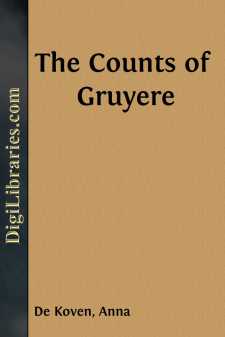Categories
- Antiques & Collectibles 13
- Architecture 36
- Art 48
- Bibles 22
- Biography & Autobiography 813
- Body, Mind & Spirit 142
- Business & Economics 28
- Children's Books 17
- Children's Fiction 14
- Computers 4
- Cooking 94
- Crafts & Hobbies 4
- Drama 346
- Education 46
- Family & Relationships 57
- Fiction 11829
- Games 19
- Gardening 17
- Health & Fitness 34
- History 1377
- House & Home 1
- Humor 147
- Juvenile Fiction 1873
- Juvenile Nonfiction 202
- Language Arts & Disciplines 88
- Law 16
- Literary Collections 686
- Literary Criticism 179
- Mathematics 13
- Medical 41
- Music 40
- Nature 179
- Non-Classifiable 1768
- Performing Arts 7
- Periodicals 1453
- Philosophy 64
- Photography 2
- Poetry 896
- Political Science 203
- Psychology 42
- Reference 154
- Religion 513
- Science 126
- Self-Help 84
- Social Science 81
- Sports & Recreation 34
- Study Aids 3
- Technology & Engineering 59
- Transportation 23
- Travel 463
- True Crime 29
The Counts of Gruyere
by: Anna De Koven
Description:
Excerpt
PROLOGUE
n the edge of a green plain around which rise the first steps of the immense amphitheatre of the Alps, a little castled city enthroned on a solitary hill watches since a thousand years the eternal and surpassing spectacle.
Around its feet a river runs, a silver girdle bending northward between pastures green, while eastward over the towering azure heights the sunrise waves its flags of rose and gold.
In the dim hours of twilight or by a cloudy moonlight, the city pitched amid the drifting aerial heights seems built itself of air and cloud, evanescent and unreal.
By the fair light of noonday, sharp and clear upon its eminence, it is like a Dürer drawing, massed lines of crenelated bastions, sharp-pointed belfreys, and towered gateways completing a mediæval vignette ideal in composition. Strange as the distant vision seems to the traveler fresh from the rude and time-stained chalets of the mountains, still more surprising is the scene which greets his arrival by the precipitous road, past the double towered gateway, within the city walls. Expressly set it seems for a theatrical décor in its smiling gayety, its faultlessly pictorial effect. Every window in the blazoned houses is blossoming with brightest flowers, as for a perpetual fête. The voices of the people are soft with a strange Italianate patois, and the women at the fountain, the children at their play, the old men sunning themselves beside the deep carved doorways are seemingly living the happy holiday life which belongs to the picture. The one street in the city, opening widely in a long oval place, is bounded by stone houses fortified without and bearing suspended galleries for observation and defence, forming thus a continuous rampart along the whole extent of the hillside.
At the eastern extremity of this enclosure beyond the slender belfrey of the Hotel de Ville and the ancient shrine where a great crucifix looks down upon the scene, a flagged pathway rises sharply under a tall clock tower within the enceinte of the castle set at the steep extremity of the ridge. There behind strong walls a terrace looks from a crenelated parapet over the descending sunset plains, a prospect as fair as any in all Italy. Within a second rampart, semi-circular in form, the castle with its interior court looks eastward and southward over the encircling valley with its winding river, up to the surrounding nether heights of the Bernese Oberland. Walls twelve feet in thickness tell the history of its ancient construction, and chambers cut in the massive stone foundations recall the rude life of the early knights and vassals who defended this château-fort from the Saracen invasion. Noble halls, later superimposed upon the earlier foundations, with stone benches flanking the walls and recessed windows overlooking the jousting court, evoke the glittering days of chivalry and the vision of the sovereign race of counts who here held their court.
Ten centuries have passed over this castle on the hill; six told the story of its sovereignty over the surrounding country, but unlike most of the châteaux of Switzerland it has been carefully restored and maintains its feudal character. The caparisoned steeds no longer gallop along the ancient road, the crested knights no longer break their lances in the jousting court; but in the wide street of the little city is heard a speech, and in the valleys and from the hillsides echo herdsmen's songs, which contain Latin and French words, Greek, Saracen and German, a patois holding in solution the long story of the past.
CHAPTER I
ORIGIN OF THE PEOPLE
riply woven of the French, German and Italian races, the Swiss nation discovers in its Romand or French strain another triple weave of Celtic-Romand-Burgundian descent....


